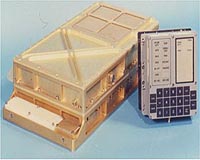 |
Leeds, UK (SPX) Jun 09, 2009 Scientists have developed a new cleaning protocol for space hardware, such as the scoops of Mars rovers, which could be used on future "Search for Life" missions on other planets. The new protocol was developed as part of a project to investigate life that exists in extreme Arctic environments, which are the closest analogue we have on Earth to the surface of Mars. The studies are also designed to help guide future NASA and ESA planetary missions. Published in the journal Astrobiology, the decontamination protocol was developed and tested by scientists at the University of Leeds and NASA. It deals with the dilemma known as 'forward contamination' - ensuring that bugs from Earth don't hitch a ride across space and jeopardise the integrity of samples collected by rovers. The decontamination protocol involves a cocktail of chemicals that were applied and tested on various sampling devices, including a glacial ice core drill and a rover scoop. "We are trying to avoid a case of mistaken identity," says Professor Liane Benning, a biogeochemist from the University of Leeds and co-author of the paper. "We know that on Mars, if present, any biological signatures will be extremely scarce. Therefore it is essential that we are able to minimise 'background noise' and to document just how clean our sampling devices really are before we use them," she adds. "We are now able to fully decontaminate sampling devices in the lab and field to null levels of detectable organic biosignatures, before any samples are collected. Importantly, this new procedure doesn't just sterilise, but it also cleans off any trace organic molecules of dead organisms," says Professor Benning. The work was carried out as part of the Arctic Mars Analog Svalbard Expeditions (AMASE) which uses Svalbard (a set of islands in the Arctic ocean at 74-80 degrees N) as an international test site for NASA and ESA "Search for Life" instrumentation scheduled to fly on future Mars missions. Svalbard is an excellent terrestrial analogue environment to Mars as life is scarce and it has a similar geology and many pristine glaciers. "This work also enabled recent habitability and biomarker preservation studies in the extreme glacial settings of Svalbard. In addition, this work will guide future planetary missions, especially those to icy regions in the Solar System, such as Mars, or the moons of Jupiter and Saturn (Europa and Enceladus) where we are interested in understanding the potential habitats of cold-loving organisms living in ice," says Dr Jennifer Eigenbrode, NASA research scientist. This work was carried out during the 2005 and 2006 field seasons of AMASE and was funded by a NASA ASTEP award to co-author Andrew Steele at the Carnegie Institution of Washington and grants from the Earth and Biosphere Institute at the University of Leeds to Liane G. Benning. Share This Article With Planet Earth
Related Links University of Leeds Space Tourism, Space Transport and Space Exploration News
 To The Moon, By Way Of MIT
To The Moon, By Way Of MITBoston MA (SPX) Jun 08, 2009 Many people consider the Apollo lunar landings one of the crowning achievements of human ingenuity. But not so many people realize that the epochal first steps by human beings on another world - which took place 40 years ago next month - likely would not have been possible without the technological experience and capabilities of MIT. In celebration of that singular accomplishment and MIT's ... read more |
|
| The content herein, unless otherwise known to be public domain, are Copyright 1995-2009 - SpaceDaily. AFP and UPI Wire Stories are copyright Agence France-Presse and United Press International. ESA Portal Reports are copyright European Space Agency. All NASA sourced material is public domain. Additional copyrights may apply in whole or part to other bona fide parties. Advertising does not imply endorsement,agreement or approval of any opinions, statements or information provided by SpaceDaily on any Web page published or hosted by SpaceDaily. Privacy Statement |